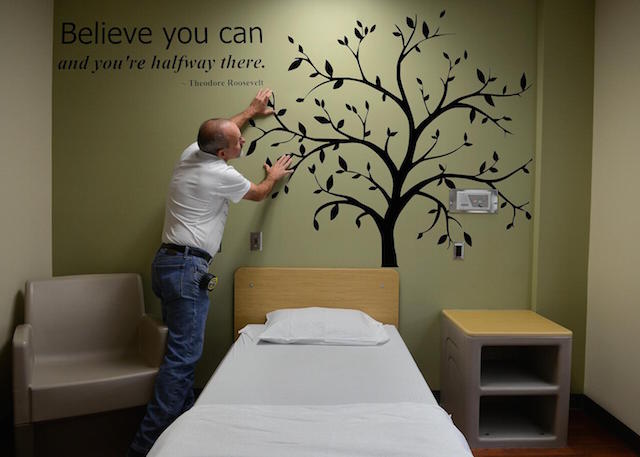A new study shows a sharp decline in suicides at Veterans Affairs inpatient mental health units from 2000 to 2015, thanks to the Mental Health Environment of Care Checklist.
The checklist, introduced into the VA in 2007 and used byvmore than 150 VA hospitals nationwide, guides staff in eliminating physical hazards at the mental health inpatient units which raise the risk of patient suicide or self-harm.
MORE: First Ever Quadriplegic Treated With Stem Cells Regains Motor Control in His Upper Body
The checklist focuses on architectural and other physical-environment changes. Earlier analyses had shown that most attempted or completed suicides on inpatient units were linked to these hazards–for example, a hook or other anchor point that could be using for hanging.
Other potential hazards include non-shatterproof glass and non-tamper-resistant electrical outlets.
The study’s lead author, Dr. Vince Watts, says the research produced two main findings.
“First, it appears that the Mental Health Environment of Care Checklist has had a substantial and persistent reduction in inpatient suicide deaths,” he says. “Second, these findings suggest that architectural and environmental changes may result in more lasting effects in contrast to other improvement strategies for reducing suicides in hospital units.”
RELATED: This Doctor Broke The Law To Engineer a Better Nursing Home, And the Death Rate Plummeted
Other strategies for preventing suicides in hospitals include training staff better, performing more frequent checks of patients, and implementing a non-punitive culture that rewards incident-reporting and supports its continued improvement.
Watts, a psychiatrist at the White River (Vermont) VA Medical Center, and the study’s other three researchers are with the VA National Center for Patient Safety, based in Ann Arbor, Michigan.
The program was created in 1999 to lead formal patient-safety activities across the VA health system. One of its first actions was to institute a root cause analysis of adverse events such as inpatient suicide.
Root cause analysis, used widely in industry, is a systematic approach that helps organizations identify and address the underlying causes of problems, instead of just “putting out fires” when they occur.
CHECK OUT: Suicide Rates Plummet Among Members of Apache Tribe
In a review of the National Center for Patient Safety’s root cause analysis database, the researchers learned of 29 completed suicides in VA mental health units from 2000 to 2015 (24 before implementation of the checklist and five after). The rate of suicide in mental health units before the program kicked off was 4.2 per 100,000 admissions. It dropped to 0.74 suicides per 100,000 admissions – an 82% reduction.
Structural changes, according to Watts, reduce the burden on hospital staff to prevent suicides.
“The checklist and resulting environmental changes involve hardwiring of changes into the architecture of mental health units,” he says. “Thus, staff don’t have to remember to do something. The unit is just designed that way.”
MORE: When a Preschool Opens Inside a Nursing Home All Heaven Breaks Loose
Another implication of the finding, Watts says, is that there may be other effective approaches that, like structural changes, create no added burden on staff. One such approach would be the increased use of automated technologies to help provide care for patients with mental illness.
“Our goal is to have no inpatient suicides in the VA,” he adds. “Our hope is that a continued focus on this approach will result in a continued reduction in suicide.”
(Source: Veterans Affairs Research Communications)
Click To Share The Good News With Your Friends – or Photo by Jeff Bowen






















The fall in inpatient suicides has occurred in many western countries, but it is balanced by an increase in the post discharge suicides and no lives are saved. However it’s nicer for the inpatient staff, but the headline is misleading in that it seems to indicate a reduction in total suicides but this has not happened